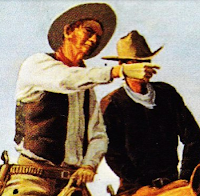For review, the Lone Ranger himself was played by Clayton Moore (1949 – 1951, 1954 – 1957) as well as John Hart (1952 – 1954). According to the opening one-hour movie that aired by ABC, the Lone Ranger would have likely perished if it had not been for Tonto nursing him back to good health in the opening one-hour debut of what became the highest-rated television series at the time.
By the end of the second season (1950 – 1951) it had accomplished a rating of #7 by Nielsen, #18 the next.As mentioned in 'Who Was That Masked Man? Celebrating the Lone Ranger,' published two weeks ago on the WMD Weblog (click here), the show itself began as a radio program in 1933 and it continued until 1949 when the program appeared on television.
Enter the Lone Ranger (1-hour flick)
The Man Behind the Mask
Tonto was first played by John Todd in the radio version of The Lone Ranger, which aired on WXYZ out of Detroit (1933 - 1949). Todd was born as John Frederick on August 14, 1876 (deceased on July 14, 1957). He was, by trade, an actor who, before becoming Tonto, played the part of a local sheriff on the same program.It was in the 11th or 12th episode that he assumed the role of Tonto, although George Trendle, the originator of the Long Ranger story and apparently the owner of the radio station, assigned the role to a younger man for a short time. It didn't take long, however, for Trendle to reassign the Tonto role to Todd again, which he kept to the end of the radio series in 1949.
The 'Tonto' that most of us are familiar with was that of Jay Silverheels, born as Harold Preston Smith on May 26, 1912, on the Six Nations Reserve near Hagersville, Ontario, Canada. He was an actual Indian, alleged to be the grandson of a Mohawk Chieftain.
Like Clayton Moore, who played the part of the Lone Ranger, Silverheels was exceptionally athletic and was known for his skill in lacrosse. According to a Wikipedia account, under the name of Harry Smith, he played indoor lacrosse with the Iroquois team from Rochester, NY. In addition, he became known as a boxer in Buffalo, NY where he, in 1938, won 2nd place in a Middleweight Golden Gloves tournament.
Silverheels' Acting Career
It was in 1937, while with a touring lacrosse team, when Silverheels caught the attention of actor and comedian, Joe Brown. Brown encouraged him to attend a screen test, which launched him into a successful acting career. He began as an extra and a stunt man in low-budget movies, serials, and westerns. In the 1940s, he played in major movies, such as James Stewart's Broken Arrow, which was featured on WMD a few weeks ago.
Most decidedly, Silverheels' greatest work was that of Tonto. His part in The Lone Ranger story line was based on events that had occurred between the two men at an earlier age. The Lone Ranger had been part of a six-man team of Texas Rangers who went after a group of outlaws who had fled to the Badlands. In an ambush five of the six Rangers were killed, leaving only one critically wounded.Tonto stumbled onto the scene of the massacre which is where he found a lone, surviving man. Tonto nursed him back to health, during which time he learned that the man he was helping was the same individual who, many years before, had helped save his own life. The relationship between the two men developed into a bond, which resulted in Tonto's decision to stick by his old friend in support of the Lone Ranger's desire to fight corruption and crime behind a mask that served to protect his true identity.
As evidence, here's the first episode of The Lone Ranger, which aired in 1949. It's one hour long and I highly recommend that you take the time to watch it. It will explain why he wore a mask, what part that the silver bullets played, and how his horse came to be known as Silver.
In Conclusion
| According to several accounts, Jay Silverheels raced horses. He was married in 1945, had three girls and one boy, Jay Anthony Silverheels, who himself went on to become an actor. Jay Silverheels was later inducted into the Hall of Great Western Performers, which is located at at the National Cowboy & Western Heritage Museum in Oklahoma City. In addition, he was named by the Western New York Entertainment Hall of Fame. | Tonto, the Man in Front of the Mask |
In 1976, Silverheels suffered a stroke and he eventually passed on March 5, 1980 at the age of 67. He lived in Calabasas, in Los Angeles County, California. After his cremation, his ashes were returned to the Six Nations Reserve.
For those of us who watched Tonto on The Lone Ranger on television, Tonto occupies a special place in our hearts. I will never forget the most ethical, moral, and upstanding way that both Tonto and the Lone Ranger lived their on-screen lives, as theyh continue to do yet today.
EDITOR'S NOTE: The memory of Clayton Moore, John Hart, and Jay Silverheels is kept alive through Internet-based organizations like The Lone Ranger and Tonto Fan Club, a fan page on Facebook (http://bit.ly/2tmkbNQ).
Tonto, from Amazon


























